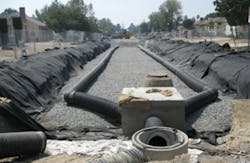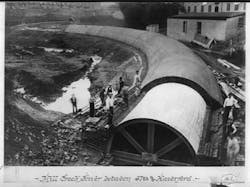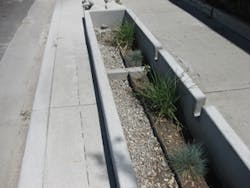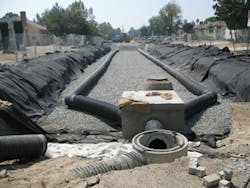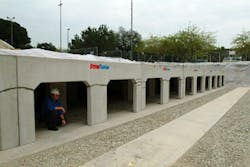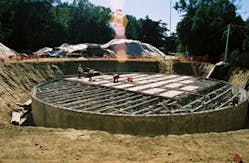A variety of factors have converged in recent years to make stormwater a particularly important topic in the United States. While regulatory requirements continue to push municipalities to devise strategies for more effectively managing stormwater discharges, the rise in extreme weather events across the country—from record-breaking floods to unprecedented droughts—is driving innovation in the area of stormwater handling and reuse. However, stormwater solutions must come at a reasonable price point with a quantifiable near-term payback, as rate increases and infrastructure investments are highly scrutinized in today’s marketplace. Faced with these realities, "green infrastructure" is playing a staring role in helping municipalities overcome their stormwater challenges.
The Stormwater Issue
Stormwater runoff is generated when precipitation from rain and snowmelt events flows over land or impervious surfaces and does not percolate into the ground. As the runoff flows over paved streets, parking lots, building rooftops, etc., it accumulates debris, chemicals, sediment, and other pollutants that could adversely affect water quality if the runoff is discharged untreated. Some stormwater discharges in the U.S. are considered point sources and require coverage under an NPDES (National Pollutant Discharge Elimination System) permit. Most states are authorized to implement the Stormwater NPDES permitting program, with the U.S. Environmental Protection Agency acting as the permitting authority for a few states, territories, and on most land in Indian Country.1
From a stormwater management perspective, the primary aims for most municipalities are to minimize flooding and to prevent stormwater from flowing into water bodies without first being treated. However, in areas where water resources are scarce, stormwater capture and use is just as important as treatment.
"The challenges of managing stormwater vary across the country due to differences in parameters such as climate, rainfall patterns, soil conditions, and the density of development," says Rachel Herbert, a physical scientist in the EPA’s Office of Wastewater Management. "Stormwater management is particularly important in urbanized areas where there are large amounts of impervious cover.
"In the past, stormwater was treated as a waste and conveyed quickly off site into nearby water bodies or detention ponds; the focus was largely on managing flows for flood control and drainage," says Herbert. "More recently, stormwater is being viewed as a valuable resource, and stormwater will likely become even more important in the upcoming years as droughts continue to impact communities. The types of pollutants conveyed in stormwater depend on the particular activities occurring on a site or facility."
The Philadelphia Stormwater Approach
Philadelphia, like many older cities in the U.S., has a Combined Sewer System, whereby stormwater flows through the same pipe along with domestic, commercial and industrial wastewater. Approximately 60 percent of Philadelphia’s stormwater system is combined, with the other 40 percent operating on a more modern system with sewage and stormwater flowing through separate pipes. All told, the Philadelphia Water Department has approximately 3,500 miles of sewers, 72,500 stormwater inlets, three drinking water treatment plants, three wastewater treatment plants, 16 wastewater and three stormwater pumping stations, 201 Combined Sewer Overflow (CSO) regulating chambers, 164 CSO outfalls, more than 3,100 miles of water mains, 17 reservoirs, five water storage tanks, and more than 450 stormwater outfalls.2
Combined Sewer Systems present a unique challenge for municipalities, as they can overwhelm the capacity of the wastewater treatment plant during periods of heavy rainfall or snowmelt. If the sewer system and/or treatment plant is overwhelmed, excess wastewater may be discharged directly into nearby water bodies with little or no treatment. This presents a potential public health threat due to pathogens and other harmful constituents that may be found in stormwater and wastewater. As such, regulations for stormwater discharges continue to tighten, and municipalities face steep fines for stormwater discharges that do not meet baseline treatment requirements, such as CSOs.
Philadelphia’s stormwater challenge is compounded by the fact that much of what were once surface creeks and streams were converted into sewers to help the city meet the needs of rapid industrialization in the mid 19th century. Natural watersheds were utilized to facilitate drainage, and most of Philadelphia’s surface creeks and streams became the framework from which conveyance pipes were planned. Placing sewers in creek beds cost-effectively used gravity flow, and leveling off the natural stream valleys allowed for subdivision of land without varied topography posing complications. To that effect, the street grid could be implemented more methodically on level land, and polluted waterways no longer interfered with inland development. Of the 283 linear miles of streams that once existed in Philadelphia to carry runoff to the Schuylkill and Delaware rivers, only 118 miles remain today. The historic erasing of these surface creeks and streams has transformed the city’s hydrological conditions forever.3
READ ALSO: EPA Issues Framework for Stormwater Runoff & Wastewater Management
In response to the stormwater issues it faces, The Philadelphia Water Department has been particularly aggressive in developing and implementing a new program to effectively manage its stormwater. In June 2011, the department initiated a 25-year plan called "Green City, Clean Waters", which aims to protect and enhance the city’s watersheds and control flooding by managing stormwater through green infrastructure.
"Stormwater is a critical area of impact if we want to get back to fishable, swimmable, drinkable," says Chris Crockett, deputy commissioner of planning and environmental services for the Philadelphia Water Department. "The other impact is flooding. We’ve seen a significant increase in the frequency of extreme events, and you really can’t build infrastructure fast enough."
While water quality and CSOs and flooding represent distinct issues, they require an integrated approach, because treating them as silos can be counter-productive, says Crockett. For example, he says eliminating CSOs typically calls for storing as much water in the pipes as possible, which could promote flooding. Meanwhile, during an extreme rainfall or snow melt, the goal is to increase flow, which increases the likelihood of CSOs. The Philadelphia Water Department is betting that an integrated approach based on a heavy dose of green infrastructure will effectively meet the needs of both water quality and flooding. Green infrastructure uses vegetation, soils, and natural processes to manage stormwater and provide environmental and community benefits. Green infrastructure practices reduce the volume and velocity of stormwater discharges and reduce the pollutant loadings into receiving waters. Green infrastructure also provides communities with many other benefits, such as reducing flooding, making neighborhoods more livable, reducing the urban heat island effect, and improving air quality.4
"An increasing number of communities and businesses are integrating green infrastructure practices in the design of projects to retain the stormwater volume through infiltration, evapotranspiration, and rainwater harvesting," says Herbert. "For example, communities are beginning to integrate bioswales and rain gardens into their road rights-of-way to reduce the pollutants contained in stormwater. They are looking for innovative ways to incorporate stormwater management into parks so that they can be multi-functional—providing community amenities while also managing stormwater."
Philadelphia is at the forefront of the green infrastructure approach to stormwater management, certainly in the U.S., and perhaps worldwide. By 2016, the Philadelphia Water Department is expected to have implemented 744 acres of green infrastructure to generate 600 million gallons in CSO reductions, and Crockett says it is on pace for about 1 billion gallons in CSO reductions. "Our goal is to really hit it out of the park at the five-year mark," says Crockett. "We want to prove that green infrastructure is a viable solution."
By 2035, the Philadelphia Water Department is expecting to have implemented 9,564 acres of green infrastructure to reduce 8 billion gallons of Combined Sewer Oveflows. From a technological perspective, Crockett says the Philadelphia Water Department is constantly evaluating upgrades, reinvestments and renewals of traditional infrastructure. However, he says traditional infrastructure investments are considered within the context of how they interact with the source control efforts being implemented through green infrastructure.
"If we’re controlling at the source, it allows us to get more capacity out of the system, says Crockett. "We’re certainly expanding flow and treatment facilities, gates, weirs—green is just another tool in the infrastructure toolbox along with grey infrastructure. The traditional infrastructure still does a tremendous amount of the work. If we want to get the most out of that infrastructure without having to build a new backbone, green infrastructure is key."
Part of the reason green infrastructure is important in Philadelphia is because the financial implications of grey infrastructure are not in line with the regulatory requirements the Water Department currently faces. By law, city water rates cannot exceed 2.2 percent of the median household income, which in Philadelphia, where the poverty rate is hovering around 26 percent5, is quite low compared to other large cities.
Another reason green infrastructure makes sense for Philadelphia is because the cost-benefit is overwhelming when compared to grey infrastructure. "If we’re looking at just traditional, we estimated $8 billion to $9 billion worth of expense," says Crockett. "We estimated $2.4 billion with green. Also, our Triple Bottom Line Analysis showed that every dollar spent on green is a dollar in benefit that comes back to the city. For a dollar spent on grey, the analysis actually showed a negative payback." (EDITOR’S NOTE: The Philadelphia Water Department’s Triple Bottom Line Analysis measured economic, social, and environmental impacts.)
As part of its stormwater infrastructure, the Philadelphia Water Department maintains an extensive flow monitoring network. Level sensors record data throughout the combined sewer system, with monitoring equipment at, or near, the 164 CSOs throughout the city. This public notification system is based on the department’s analysis of monitoring network data, which is used to determine the likelihood of CSOs. Flow monitoring data is validated with the Philadelphia watershed and wastewater conveyance model. This model was developed using the U.S. EPA’s Storm Water Management Model (SWMM). Real-time rainfall data is taken from the PWD rain gauge network and run through the model to estimate where and when overflows are occurring. Model output is then used to validate the monitoring data, ensuring a second level of accuracy.
The Philadelphia Combined Sewer Overflow Public Notification System (CSOCast) is a pilot program, which aims to improve the city’s notification system, flow monitoring network, and SWMM Model in order to deliver the best information possible to the public.5 Ultimately, Crockett says the Water Department’s goal is to have stormwater infrastructure that is fully sensored so it can detect failures and performance issues before they have a negative impact. For example, he says the department is experimenting with green stormwater inlets that pre-treat stormwater before it gets into the water infrastructure. Sensors are being employed in these systems to determine when the pre-treatment filters need to be cleaned. Crockett says sensors are also being employed to determine when and where green infrastructure stormwater inlets are being clogged so the department can devise appropriate response mechanisms and/or determine if a redesign is necessary. Crockett says the reason Philadelphia has been able to set such lofty goals for its green stormwater program and is on pace to exceed them is because it is in an ideal situation.
"A wise mentor of mine once told me something, and I never forgot it," says Crockett, "He said, every idea you’ll come up with has already been thought of or tried by somebody else; the only things that change are people, politics, money, and technology. If you don’t have three of those four things in your favor, you’re not going anywhere. In Philly, we have four of four." With the support of Mayor Michael Nutter, the Philadelphia Water Department has been able to successfully launch it’s "Clean City, Green Waters" program, and Crockett is incredibly optimistic about its potential going forward. "It’s like the iPhone," says Crockett. "We’re on version one right now; maybe version two. The product won’t be really awesome until we get to version five."
LA Aims to Make the Most of Its Stormwater
While the Philadelphia Water Department is very much focused on water quality and flooding, the Los Angeles Department of Water and Power (LADWP) is focusing on stormwater capture and reuse.
Over the past decade, the LADWP has been working to increase stormwater capture within the City of Los Angeles. With higher demands and strains on imported sources, such as the State Water Project, LA Aqueduct, and the Colorado River Aqueduct, the LADWP is looking to develop water supply sources locally to meet growing demand and reduce the city’s dependence on imported water supplies.
Still under development, the LADWP’s Stormwater Capture Master Plan (SCMP) was undertaken to help guide and set goals for the Stormwater Capture Program. "We currently capture an average of 27,000 acre-feet per year of stormwater at existing spreading grounds in San Fernando Groundwater Basin," says David Pettijohn, director of water resources for the LADWP. "The initial modeling results have shown that much more potential exists for capture in both large centralized facilities and smaller distributed projects."
The next step for the LADWP’s SCMP is to develop a suite of projects to be implemented as part of the Stormwater Capture Program. These projects and programs will be modeled to determine which capture scenario yields the greatest water supply benefit. A draft of the modeling results will be available for public review around December 2014.
The LADWP has adopted a comprehensive strategy to develop local water supplies. These supply augmentation strategies include:
- Increase water conservation;
- Increase recycled water usage;
- Enhance stormwater capture; and
- Clean-up local groundwater basin.
The overall goal is to diversify the city’s water supply portfolio. Each of these initiatives helps reduce the amount of imported water. As an example of the program’s success, since 1970 the City of Los Angeles’s population has increased by over 1 million people, yet the water demand has remained generally flat. Water use efficiency has been a major driver of this success.
"The LADWP’s traditional stormwater management strategy has been to focus on the use of dams and large centralized facilities such as spreading grounds, for capture and recharge of the local groundwater aquifer," says Pettijohn. "These facilities are located in the upper watersheds of LA County and most are owned and operated by the LA County Flood Control District (LACFCD)."
The SCMP will identify opportunities to augment the traditional strategy, as well as apply new strategies that includes green infrastructure within the public right-of-ways and smaller-scale systems that homeowners and businesses can implement within their properties.
The goal of the SCMP is to help the LADWP outline strategies to implement stormwater and watershed management programs and projects. In working with other partners/agencies that share similar goals, many potential projects have been identified. "Because each of these other agencies have a specific mission, such as storm runoff water quality or flood control, we look to partner on projects that also have a water supply benefit," says Pettijohn. "Based on the metrics we’ve developed, projects/programs will be ranked based on the perceived benefits. The rankings will only serve as a guide, but generally speaking the higher ranked projects will be pursued first."
Some of the metrics LADWP considers when evaluating whether to invest in a project are expected capture volume, cost per acre-foot, year of first payback, ease of implementation, etc.
Many cities across the southwestern United States have used traditional stormwater capture methods through the use of dams and spreading facilities. Some cities in dry climates have been developing neighborhood-scale stormwater capture and reuse projects for a longer time period than the City of Los Angeles. "Our approach is to review successful neighborhood-scale stormwater projects used by other cities, and evaluate if they are applicable in Los Angeles," says Pettijohn. "The SCMP is not based on any specific model currently used for Stormwater Capture.
"Many studies have been published in regards to water resource issues in the Los Angeles region," says Pettijohn. "Our methodology includes the review of published material so as to build on existing body of knowledge and not duplicate efforts."
LADWP has a strong public outreach program toward communities and businesses to promote small-scale stormwater capture projects and programs. The City of Los Angeles also has an ordinance that requires any new construction to incorporate LID (Low Impact Development) and BMP (Basic Management Practices) techniques. New construction projects must account for stormwater capture as part of the design, and Pettijohn says industries are becoming more aware of their environmental impact, and some have even begun seeking and inquiring ways to be involved in maintaining sustainable water supplies.
LADWP has identified a suite of potential projects that are planned for implementation in the next 5–10 years. Many of these projects include retrofits of dams and spreading facilities, but there are also many more that involve neighborhood-scale stormwater capture and reuse. Because the City of Los Angeles is heavily urbanized, the challenge will be to continue to identify new projects to maximize the potential identified in the SCMP. Funding will also be a challenge. "By working with our partner organizations, we can leverage resources and reduce the burden on ratepayers," says Pettijohn. "We hope to implement and expedite projects with the highest cost-benefit ratios as we strive for making stormwater a reliable water source for the City of Los Angeles."
Matt Migliore is the director of content for Flow Control magazine and FlowControlNetwork.com. He can be reached at 610 828-1711 or [email protected]. Follow Matt on Google+. Connect with Matt on LinkedIn.
References
- "Stormwater Homepage," U.S. Environmental Protection Agency, water.epa.gov/polwaste/npdes/stormwater/index.cfm.
- "Water Infrastructure Management," Philadelphia Water Department, www.phillywatersheds.org/watershed_issues/infrastructure_management.
- "Philadelphia Watershed History," Philadelphia Water Department, www.phillywatersheds.org/your_watershed/history.
- "Green Infrastructure," U.S. Environ-mental Protection Agency, water.epa.gov/infrastructure/greeninfrastructure/index.cfm.
- "Philadelphia County, Quick Facts," U.S. Census, census.gov/quickfacts/fact/table/US/PST045216.
